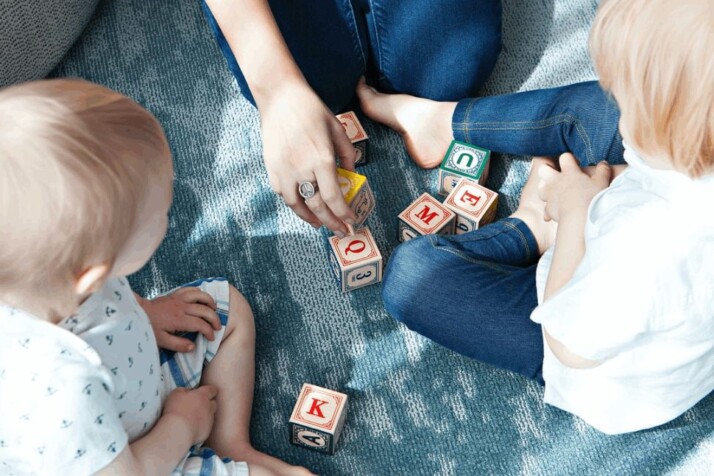Reading is a life skill that kids will carry with them into adulthood. Throughout a child’s reading development, it’s important to keep in mind the 5 components of reading. They are phonics, phonemic awareness, fluency, vocabulary, and comprehension.
Phonics
Phonics is the act of matching letters of the alphabet with sounds, which helps children learn to read. This is done through visual, auditory, and kinesthetic learning, also known as the learning pathways.
Phonics is the relationship between written letters and spoken sounds in a language. With phonics, children learn the sounds of consonants, vowels, stops, and nasals that make up the words. According to the National Reading Panel, systematic phonics teaching can significantly help children learn to read efficiently.
It includes learning the alphabet, blending them into words, and reading words that contain the same phonics sounds. For example, the word “pen” can be read in two ways: “p-e-n” as in “pencil” or “p-a-n” as in “pan.”
Phonemic Awareness
Phonemic awareness is the understanding of how to break sounds into individual parts. This is difficult for some children, while others have no difficulty with it. This is why parents need to start teaching their children phonemic awareness early.
Learning about sounds, syllables, and words helps children develop phonemic awareness. It is the ability to recognize the syllables in spoken words, think about the sounds, and manipulate them in several ways. It includes blending, breaking, or changing words to demonstrate phonemic awareness.
For example, recognizing that the words “cat, cow, and car” start with the same starting sound. Blending separate sounds like “/c/, /a/, /p/” to map the word “cap”.

Fluency
The third component of reading is Fluency, which is the ability to read without thinking about words. Learning to be more aware of the words you read to improve your fluency helps you read faster and comprehend better.
Fluency plays a significant role in making sense and improving reading comprehension. It enables your child to read and speak without having to stop frequently for decoding words. Fluent readers can read accurately with proper speed and expression.
Guided oral reading can positively influence your child’s word recognition ability, reading fluency, and comprehension of texts.
Vocabulary
Vocabulary is the ability to understand words in context and use them appropriately when reading or writing. It has a crucial role in developing reading comprehension. With a well-developed vocabulary, your child will be able to make more sense of a text, be it oral or print.
Reading storybooks and listening to English conversations all contribute to incidental vocabulary learning. Additionally, students should be actively engaged in activities that include growing vocabulary both directly and indirectly.
Since vocabulary is the cornerstone of all languages, it is vital for academic and reading success. Reading and understanding texts become easier when you have enhanced vocabulary knowledge.
Comprehension
Comprehension is a cognitive process readers use to identify the main idea and key details of a text. Well-developed vocabulary is a fundamental element of improved reading comprehension.
Children are more likely to develop text comprehension better through interactive question-answer sessions and rereading the text to solidify the concept. Acquiring the skill of comprehension is not an easy process; it demands time and effort.
Consistent practice can significantly improve understanding of texts and help in academic and professional settings. A great way to enhance your child’s comprehension skills is to encourage them to talk about what they read and understood from a text. But make sure to keep the activity light and lively.
Wrapping Up
Reading is a complex task that requires the coordination of many different skills. When you learn the 5 components of reading, you increase your chances of becoming a successful reader.
It’s important to note that becoming a better reader requires commitment and dedication-even when learning how to read. This is because reading is a learned skill, not a trait. If readability is something you want to promote, this might be a helpful article.
Explore All Readability Articles
What is Reading? — Making Sense of Letters and Symbols
When studying the English language, you should familiarize yourself with its different concepts. It includes spelling, vocabulary, grammar, and reading.…
What is Readability Score? — a Quick Guide
Your text should cater to all kinds of readers. When you’re writing an article that intends to reach various individuals,…
Causes of Reading Comprehension Problems
Reading comprehension is the ability to understand and interpret written words, connecting the information in the text with previous knowledge.…
What Is ZPD Reading Level?
Everyone unique and we all have a unique understanding of the world. So what should the level of difficulty be…
The Best ELL Strategies for Reading!
Non-native English speakers can be proficient readers in their original tongue. However, those who are enrolled in an ELL (English…
These Are the Best Practices in Reading!
Best practices have been a topic of discussion in the reading education community for a long time. Among these best…
